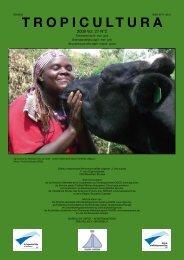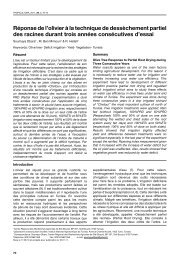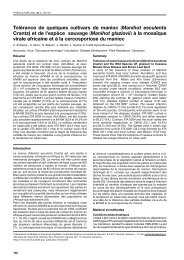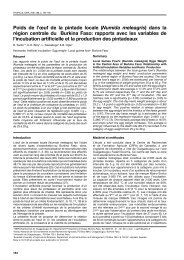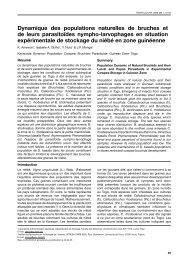Fascicule entier - Tropicultura
Fascicule entier - Tropicultura
Fascicule entier - Tropicultura
Create successful ePaper yourself
Turn your PDF publications into a flip-book with our unique Google optimized e-Paper software.
smallholder farm units. The grouping was entirely<br />
based on the subjective assessment of the key village<br />
informant and not on the size of farmland. One farm<br />
unit was then randomly selected from each stratum<br />
for the study.<br />
Data collection<br />
Leaders in cassava research in the national agricultural<br />
research systems in each country administered survey<br />
questionnaires to local farmers and took various<br />
measurements.<br />
A rapid rural appraisal technique was employed to<br />
collect village-level information in the Phase I survey.<br />
Farmer groups consisting of men and women of wide<br />
age range were constituted and interviewed in each<br />
village. A structured questionnaire was used to collect<br />
qualitative information on the following aspects among<br />
many others: various production practices, cassava<br />
processing methods including cassava products<br />
processed, cassava marketing including cassava<br />
products marketed, village level altitude; mid-altitude<br />
refers to all the sampled villages that are more than<br />
800 m above sea level and low altitude refers to all<br />
villages less or equal to 800 m above sea level. This<br />
survey was conducted in 1989-1991.<br />
Phase II survey was aimed at detailed characterization<br />
of the cassava production methods at the field level.<br />
The field-level information which was collected from<br />
all crop fields of the selected farm units included, field<br />
history, inputs applied, cassava root yield along with<br />
some agronomic yield components and field size.<br />
This information was collected in 1991 from the same<br />
villages as in phase I.<br />
Phase III survey was at the household level, also<br />
in the same villages. Relevant male and female<br />
Figure 1: Household cassava market participation decisions with transaction costs (Source: 8).<br />
TROPICULTURA<br />
household members were interviewed with structured<br />
questionnaire and relevant measurements taken. The<br />
information collected included quantity of cassava<br />
products sold or purchased for consumption, access<br />
to cassava price information in locations other than<br />
where marketed, type of cassava products processed<br />
by the household, household cash income and sources<br />
of the cash income, household composition and<br />
characteristics, etc. This information was collected in<br />
1992.<br />
Conceptual framework<br />
A farm household will choose to participate in the<br />
cassava market if the net present value of the expected<br />
benefits from participation is greater than the net<br />
present value of remaining autarkic – net of costs.<br />
Costs here include all transaction costs the household<br />
faces in the process of market participation. Past<br />
studies suggest that the failure of many households<br />
to participate in commodity market is explained by<br />
transaction costs (5, 8, 10, 12). In areas with imperfect<br />
market and high transaction costs, it is costly to<br />
discover trading opportunities. Similarly, poor market<br />
access increases a household’s cost of observing<br />
market prices to make transaction decisions, which<br />
reduces the household’s leisure time (20).<br />
These costs drive a wedge between the household<br />
shadow price and the market price of food products<br />
as shown in figure 1. The X-axis of the figure shows<br />
the value (shadow price) of cassava products to the<br />
households.<br />
The Y-axis shows the market price of cassava products<br />
paid or received by a household participating in the<br />
market. It transaction costs (i)= 0, the household<br />
131



